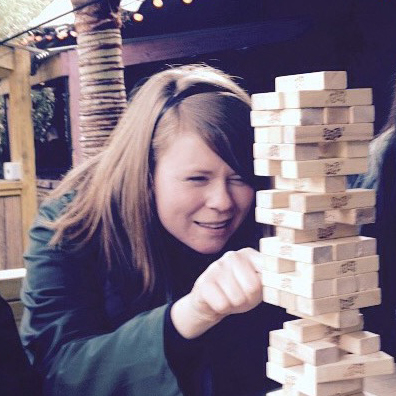The University of Cambridge Museums’ Museum Remix programme has been welcoming fresh perspectives onto our collections since 2018.
In 2018, we worked with members of Museum Detox to create a workshop format bringing together students, early career museum professionals, activists and volunteers from across the country to explore and critique the collections. In 2019, we built on that experience, working with tour guides from our Bridging Binaries LGBTQ+ tour programme to explore LGBTQ+ themes and create a pop up exhibition. These two-day events were intense, but exhilarating: a chance to gather to explore and discuss the collections, and create new thinking together.
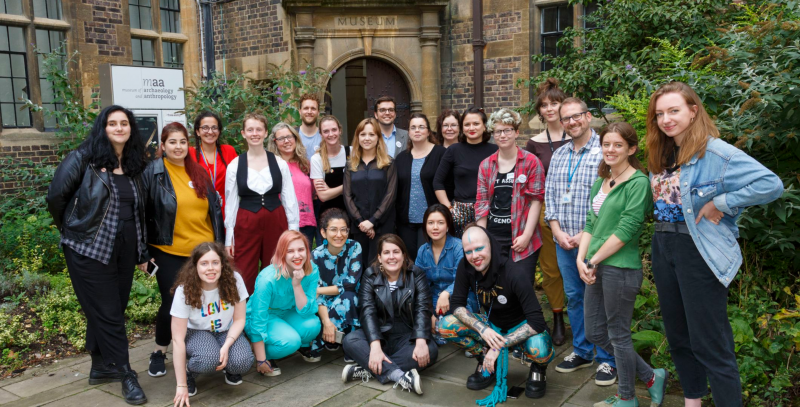
As 2020 opened, we were excited to begin planning another two day Museum Remix – and, with digital specialist George Doji joining the UCM Team, a series of smaller scale, digital-focused workshops too. Then, of course, COVID-19 made in-person events impossible. What now?
Luckily, we had just developed Discover, a new part of the UCM Website, to hold digital content such as videos, podcasts, livestreams and games produced across the UCM, including the digital exhibition and artwork from the 2019 Remix workshop. This year, we had also implemented a new Volunteer Makers platform, allowing us to set up challenges and stay in touch with remote volunteers in a way we wouldn’t have been able to before… We had what we needed to take the Museum Remix approach online.
Designing an online project
Drawing on the spirit of lockdown crafts, Museum Remix: Unheard invites the UCM’s digital audiences to tell the stories they think are important about our objects, in whatever creative way they wish. The only limit we set was the medium, running three challenges: audio, visual art, and video. In planning the project, we were guided by the following points:
Ethos
In the spirit of the Museum Remix, Unheard’s content needed to be honest and hard-hitting, opening a dialogue with participants, and ideally directly connecting them with museum staff. We invited curatorial colleagues from across the UCM to record 2-minute introductory videos about objects they felt were ripe for remixing – not easy when COVID-19 restrictions meant almost all of us were unable to visit the collections.
The Museum of Classical Archaeology’s Sade Ojelade introduces her chosen object:
One of our curatorial colleagues told us,“I would like to find out more about how our audiences feel about this kind of object – what they are interested in and want to learn more about, and what is irrelevant or boring to them. I would like to find out more about visitors’ emotional responses to objects, which is often something that gets lost in the curatorial process.”
George bravely took on a hosting role, recording videos to introduce the project and each challenge, as well as hosting two Live Q&As on YouTube to give participants the opportunity to ask further questions of museum staff. The Live Q&As meant learning how to hook YouTube up to Zoom. We are now basically wizards.
George introduces the project:
Practicalities
With many of us across the museums involved in the emergency response and, later, planning for reopening, the project needed to be flexible as the situation developed. We settled on a modular approach: a series of challenges focusing on different media, lasting roughly a month, so we could adapt the project’s length, as we needed to while creating fresh experiences for our participants.
Ease of use
It had to be easy for participants and staff to take part, with minimal special equipment required. We felt we were on fairly safe ground as, in the UK, 99% of young people aged 16-30 now have access to the Internet, but we wanted to stress that you did not need fancy skills or equipment to take part – basic hardware would fit the bill.
Building relationships
We’ve met brilliant people through the Museum Remix programme, many of whom have continued a relationship with the UCM. We wanted to be able to build a relationship with this year’s participants as remote volunteers, and easily promote the opportunity to our existing volunteers. UCM Opening Doors Project Coordinator Niki Hughes was raring to put the Volunteer Makers platform into action.
Niki says, “Volunteer Makers has been up and running for just over a year and the exciting thing about the platform is that it allows us to easily advertise the different opportunities that we have across UCM for everyone and anyone to get involved, no matter where they are located. It also means any information we have about our volunteers is stored securely. I’m really keen to expand our remote volunteering offer and this seemed like a good opportunity to try something a bit different. Lockdown, of course, meant that in-person volunteering as we know it hasn’t been possible while the museums have been closed. It’s been good to see some of our existing volunteers taking part as well as that we’ve welcomed in new faces.”
On a practical level, we built on previous UCM co-curation project models, including 2018’s Climate Hack and previous Museum Remixes, in using Creative Commons rights for all submissions.
Look and feel
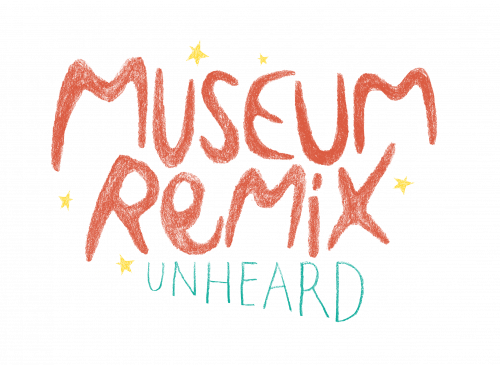
We wanted to create an inviting look and feel for the project, invoking its DIY nature while still remaining respectful to the subject matter. Jasmine Brady, a member of the Change Makers Action Group, and trained illustrator, developed the hand-drawn animations that make the Museum Remix videos so distinctive. Jasmine says,
“During lockdown my role changed a lot. I had fewer on-site responsibilities and was able to lend both of my hands to Museum Remix. I took part last year and it was excellent, so I was really glad to be able to be involved again. I took on the role of editing the videos and helping out with some logo designs. The goal was to give the project a fun, spontaneous and homemade vibe, which I achieved through knowing very little about video editing when I started the project. There was a definite theme of learning and adapting in a creative and encouraging way, which I think is central to the experience of being involved in Remix as a participant or as a facilitator. Also, spending so long with the object videos forced me to learn a lot of interesting facts.”
Letting go the reins
From the start, we committed that content created by participants in Museum Remix: Unheard would be shared by us on our digital platforms. Museum Remix is about letting go of the institutional reins, welcoming and listening to interpretation from voices beyond our organisations. We want to be the kind of university museums where we aren’t just holding knowledge about collections (and defining what “knowledge” looks like), but giving up space for experimentation, debate and challenge. It was important that we didn’t make the interpretative decisions about Museum Remix content, and were lucky to be able to work with (to date), two brilliant colleagues, Marenka Thompson-Odlum and Lucian Stephenson, as Guest Curator. Their content selections have been made into online exhibitions, using the platform appropriate to the medium: video for the audio challenge, long-form storytelling platform Shorthand for the visual art challenge.
Marenka introduces her selection from the Audio Challenge:
We are hosting all the submissions on the hosting platform that best fits the content (e.g. YouTube for video, SoundCloud for audio), lending participants the reach of our social media audiences. The content is brought together on the UCM Discover page, allowing us to offer visitors to our site perspectives and interpretations from a variety of different voices.
What did we receive?
Bowled over isn’t the word: we’ve received over 30 artworks so far over three challenge. Audio has been the most popular medium to date (though our final video challenge hadn’t closed at the time of writing). Each submission has been shared on UCM social/digital channels, with the Guest Curators’ picks uploaded to our Discover page.
Hannah’s favourite submission so far
The Ballad of Arthur Hardman by Theo Sayers (Audio Challenge). I’ve loved every single one of the submissions, but this one is an earworm. I love how Theo has interpreted the story of quarryman Arthur Hardman, as introduced by Liz Hide in her Barrington Rhino video. (There’s some creative licence in there – history doesn’t record if the relationship between Mrs Hardman and Arthur was quite as frosty as the song suggests – but I love that the song fleshes out a narrative about the man frozen in an archive photo.)
This is joint-favourite with Foraminifera by Laura Grace Simpkins. Beautifully written and narrated, Laura takes us a journey from Charles Elcock’s microscope slides in their case in the Whipple Museum to the pink sandy beaches of Bermuda and calls for “a queer, sandy kind of science”. I was fascinated by Marenka’s interpretation of it.
Jen’s favourite submission so far
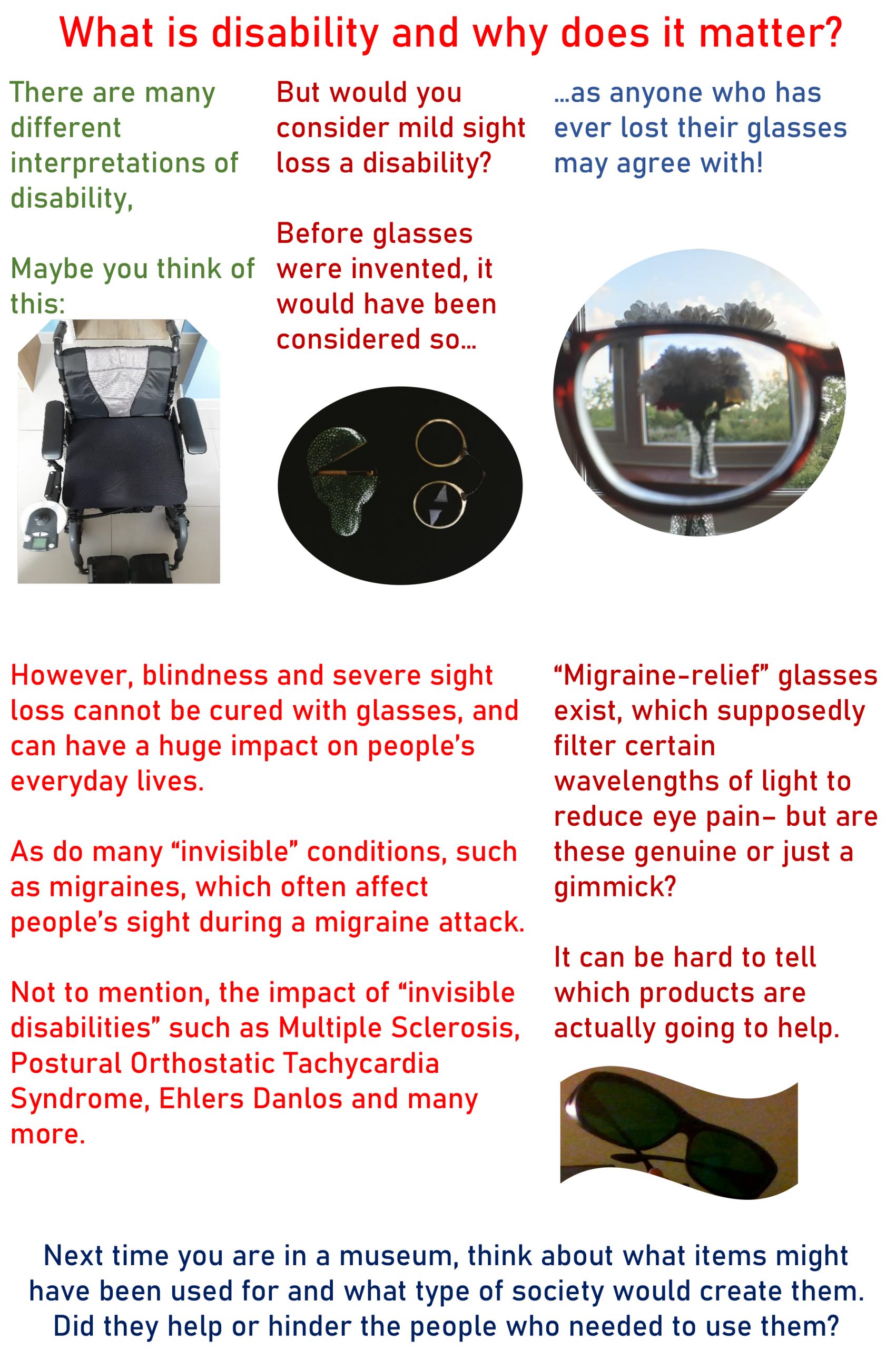
Zowie Sweetland’s poster What is disability and why does it matter? is my favourite of the submissions – though I loved them all. Zowie’s piece responded to the 18th-century spectacles in the Whipple Museum. The thought provoking poster aims to highlight invisible disabilities to the viewer, and explores the idea of whether certain ‘products’ created to aid and assist can actually be a help or hindrance.
Bridging Binaries Volunteer Meg Roberts introduces the Whipple Museum’s 18th-century spectacles:
What do participants say?
In feedback we’ve received so far, participants have highlighted:
“I thought it would be an interesting way to get creative and political during lockdown”
“It seemed a really interesting, engaging project that helped me reignite some creativity which had burned out over lockdown.”
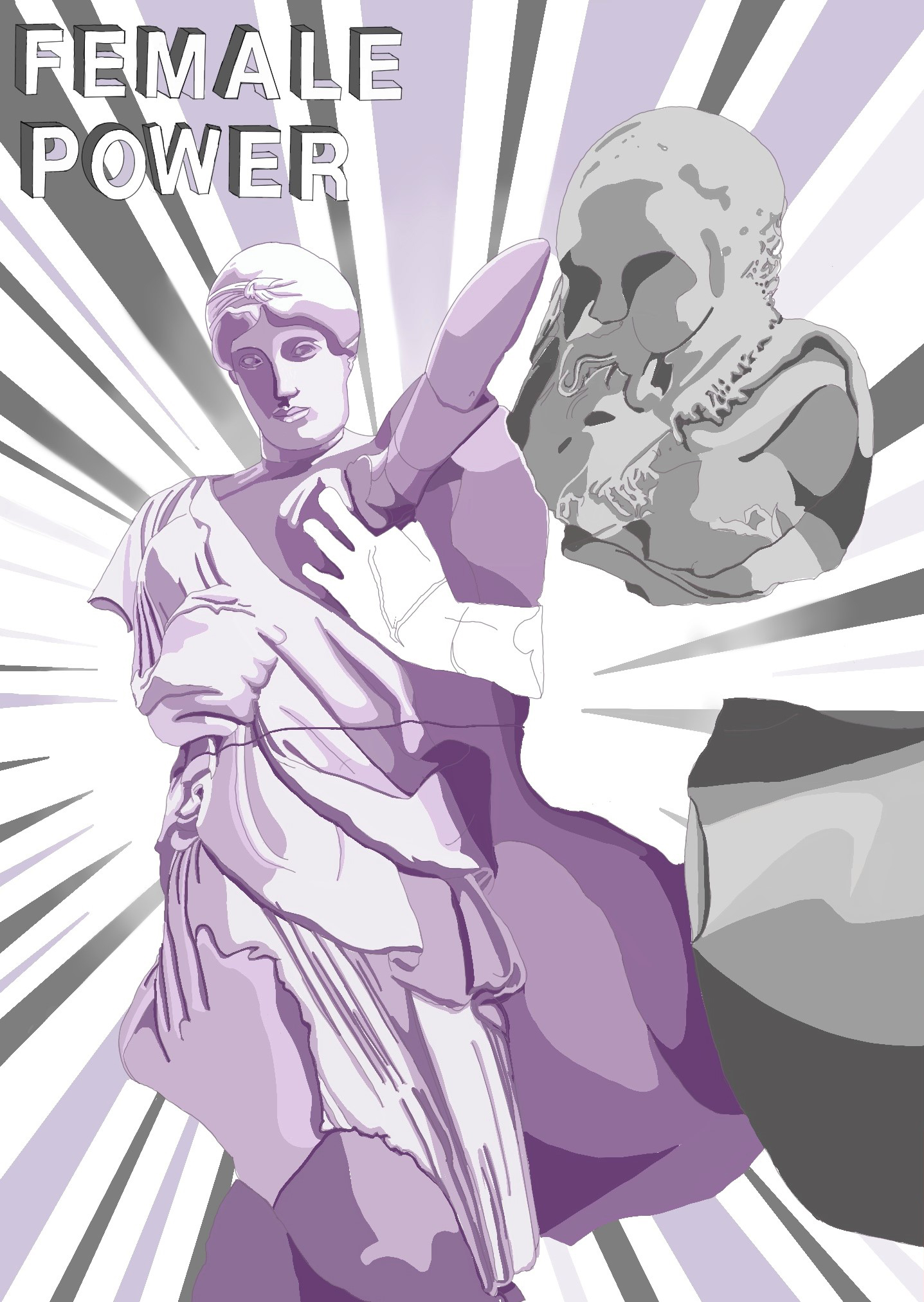
Our learning curves so far
This was an entirely new way of working for us, and, as people that love both museum objects and people, challenging in that we weren’t able to work directly either with museum objects or people! We will be producing a full evaluation report once this phase of the project is complete, but here are some of our learning curves so far:
Consider the user journey
Yes, it sounds so obvious, but in the frenetic April of 2020 we were so keen to launch the project that we didn’t do this in as much depth as we would have otherwise. In this case, we ask our participants to bounce between the main UCM website and Volunteer Makers and a Google form to submit their submissions: there is a slicker way to do this no doubt!
Buffering… buffering…
We underestimated how long it would take the delivery team to process digital content, especially working from home on temporary set ups. We had budgeted time for editing, but the seemingly simple process of downloading, processing and uploading files can take AGES, especially on dodgy home broadband.
Getting the balance right
Related to the above: we launched challenges more or less back to back in order to keep up momentum, but there’s definitely a sweet spot between momentum and burn out for the delivery team. Several elderly laptops grew very hot!
Social media is crucial
And, in relation to momentum, we didn’t anticipate how crucial consistent social media promotion would be, as well as promoting the opportunity via Arts Council England and other organisations. The project has given us an incredible wealth of unique stories to share, but doing justice to these consistently at a time when we were at reduced comms capacity due to the demands of the pandemic proved a challenge. We will of course continue to share them after the final challenge closes.
Learning from an open-ended approach
This format enabled us to try a more open-ended, cumulative approach with a large group of people, very different to the intensity of previous Museum Remix workshops which brought twenty folk together into a room for two days, and a different kind of engagement. It was a very interesting experience from our end, and we’re keen to know what our evaluation can tell us about the quality of participants’ engagement. (If you’re reading this and you took part, we’d love to hear your thoughts!
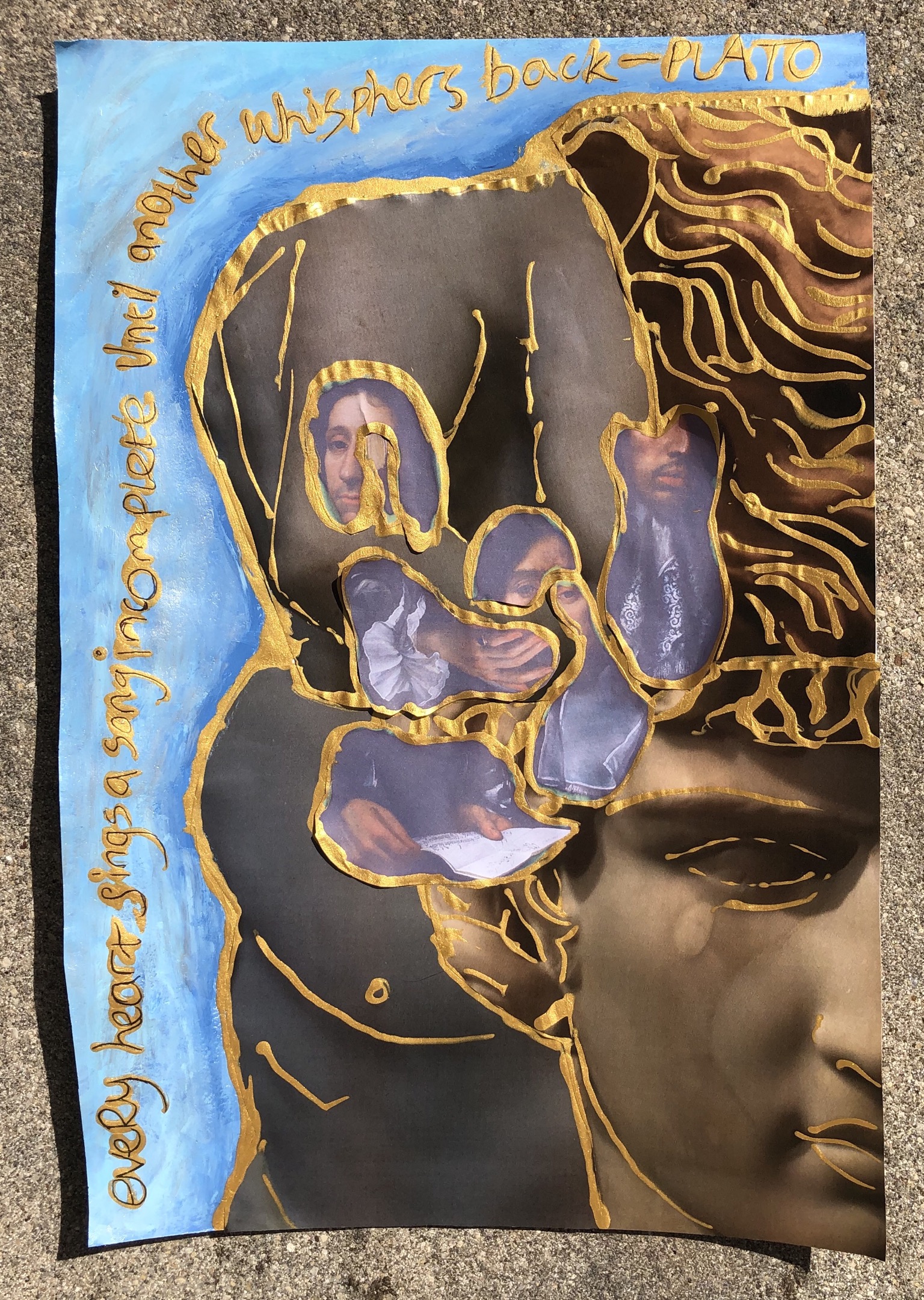
Thomas Chandler’s collage A Song Incomplete was inspired by portraits of Sir John Finch and Sir Thomas Baines by Carlo Dolci, in the Fitzwilliam Museum.
The collage overlays extracts from their portraits onto an ancient sculpture of Antinous, the lover of the Roman Emperor Hadrian.
What next?
“When we come to (re)display the objects we selected, I hope that we will be able to represent a range of voices rather than the standard ‘received’ histories or narratives that the museum has historically presented to visitors.” – Museum staff.
At the time of writing, there are still a few days to run on our third challenge (video), but we are planning Phase 2 of the project, which will see us explore how we can make the digital interpretation created through Museum Remix available from the galleries. On a more permanent level, we are also keen to explore how community-generated interpretation can be included on the museums’ databases. This might sound a bit nerdy, but in museum terms it means that community-generated content is recorded in the same way as curatorial research, enabling us to build up a picture in the long term about how objects have been responded to.
We will also be producing a full evaluation report, so keep an eye on this blog. Thank you so, so much to everyone who has supported or taken part in the project so far!


